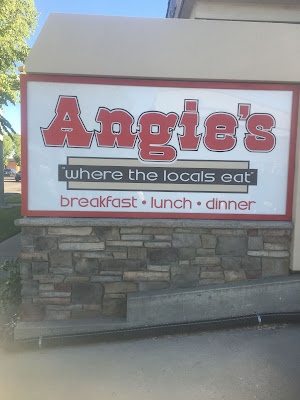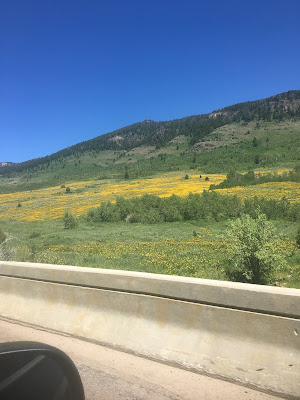Somewhere I had read that Utahns have a real affinity for scones. I thought this a little strange given that the couple of times I bought a scone at Starbucks I thought they were rather dry with not a lot of taste. I viewed a scone as that proper uptight aunt in a family of doughnuts. I was soon to discover that a scone in Utah is unlike any scone elsewhere.
I had gotten on the internet and read some reviews about a few places in Logan that had scones on the menu. One place in particular stood out in terms of people's positive experiences with scones.
ANGIE'S
Logan, Utah
An Afghani immigrant, Saboor Sahely, opened Angie's for business in 1983. This gentleman started as a dishwasher at the same site but at that time it was a Sambo's. (If you're over 50, you should remember Sambo's, that oh-so-racially-insensitive restaurant with 1,117 locations in 47 states and that went bankrupt in 1983). He then got a $10,000 loan to buy the building and named the restaurant after his two year old daughter. Sahely's success has made him into a generous philanthropist. For example, on Thanksgiving, the restaurant serves a free traditional Thanksgiving dinner to anyone who shows up, typically 1,200 to 1,300 locals.
Angie's is by far the largest restaurant we have eaten breakfast at on the tour. Upon entering through the door, I noticed a large room to the right lined with booths surrounding about 15 tables in the middle. Most of the seats were filled. We were seated in the front room which mostly contained booths and a long counter with at least 15 chairs in a row. On this morning, most of the stools were occupied by men who seemed so comfortable that they were my likely candidates of those who might eat all three meals of their meals in one day at Angie's.
Logan is predominately Mormon and Mormons, on average, have large families. Angie's has made the necessary preparations.
4 1/2 out of 5 stars
FOOD: The Healthy One was stunned when I gave my order to our server. "Are you okay?" she asked after I ordered yogurt, granola, bananas, and a scone. I said I felt fine but that I had read that the scones were really huge. I didn't want to over do it.
The "healthy stuff" was brought to the table first. It was somewhat disappointing, reminding me of those inclusive breakfasts at a Quality Inn or Ramada. I guess I was expecting something more "home made" except for the bananas of course.
It was huge, but that was no scone. It was the fried bread of my youth, purchased at the local fair or sporting event concession stand. Except this fried bread wasn't laden with powdered sugar, the dusty white treat that usually got all over your T-shirt making you look like you just returned from a cocaine frenzied Hollywood party.
It turns out that the Utah or Mormon scone is unique to Utah. The scone as I know it and the rest of the universe knows it, is baked quick bread cut into various shapes (e.g.,wedges, diamonds, rounds) and that originated a long time ago in Scotland. This free form piece of bread dough fried in oil covering my plate has always been a popular part of Mormon food culture. Some think that it might have been brought back by Mormon missionaries from Navajo communities because of its similarities to Native American fry bread. Others think that it originated on the Great Plains with the Mormon "exodus" because it provided high calorie, high energy, food that didn't spoil.
Regardless of how it originated it became known as a scone in Utah sometime during the 1960s. My thorough internet research revealed no real reason why fried bread became known as scones only in Utah. It also raises the question of what Utahns call those wedge shaped baked breads that are sold at Starbucks. Maybe, the traditional scone is not even sold in Utah. I never checked.
I thought my Utah scone was pretty bland. Even slathering it with the accompanying honey butter didn't turn my taste buds on. I decided that some fresh honey poured over it would be the perfect way to kick up the taste. This was the Beehive State wasn't it? So I asked for some honey and it was promptly delivered.
Smuckers?? Noooooooooo!
The Healthy One had a three egg vegetarian omelet with sauteed onions, mushrooms, green peppers, tomatoes, cheddar cheese, and topped with avocados. It came with hash browns and toast. She thought it very tasty.
Looking around at other tables, it appears that you get a lot of food for a reasonable price and that may be the number one reason why Angie's is so popular.
3 1/2 out of 5 stars
COFFEE: Given that Mormons don't drink coffee I wasn't expecting much and what I got was what I expected. The coffee was so-so with little boldness.
3 out of 5 stars
3 out of 5 stars
SERVICE: I learned that Angie's has between 40 and 45 full-time employees. A number of them came to our table. One took our order, another delivered our food, another checked up on us and asked if there was anything we needed (how about some decent honey young man?) and others came by with coffee refills. They were all young, clean cut, polite, and very pleasant.
4 out of 5 stars
.
4 out of 5 stars
A FEW WORDS ABOUT LOGAN:
Logan is located in the Cache Valley of northern Utah. It was originally the hunting grounds of the Shoshone tribe. The town was founded in 1859 by settlers sent by Brigham Young to build a fort and was named after Ephraim Logan, an early fur trapper.
Today, Logan has a population of approximately 50,000. It is home to Utah State (enrollment 23,000) which is the city's largest employer. The Church of Jesus Christ of Latter-day Saints (LDS) dominates the city's character. Seventy-five percent of the population are LDS members, compared to 60% for Utah as a whole.
Much of Logan is laid out according to Joseph Smith's vision of what a spiritual utopia should look like. Smith called his vision the Plat for the City of Zion. The plat provided details on such things as the width of the roads, the size of the blocks, the setback of homes, and the placement of religious and civic buildings. Many streets in Logan are 132 feet wide which was stipulated in the plat. It would take the chicken a good amount of time to cross that wide of a road. Blocks are 10 acres in size, that's 660 feet on each side. In other words it's two football fields from one intersection to the next. The coordinate-like naming of the streets can be infuriating to a stranger. Here is an example of eight actual street names in Logan:
W 800 N St.
E 800 N St.
N 800 E St.
S 800 W St.
N 800 W St.
S 800 E St.
W 800 S St.
E 800 S St.
Be very careful when you enter an address into Google maps.
BURN THOSE BREAKFAST CALORIES OFF:
Logan is located in the Cache Valley of northern Utah. It was originally the hunting grounds of the Shoshone tribe. The town was founded in 1859 by settlers sent by Brigham Young to build a fort and was named after Ephraim Logan, an early fur trapper.
Today, Logan has a population of approximately 50,000. It is home to Utah State (enrollment 23,000) which is the city's largest employer. The Church of Jesus Christ of Latter-day Saints (LDS) dominates the city's character. Seventy-five percent of the population are LDS members, compared to 60% for Utah as a whole.
Much of Logan is laid out according to Joseph Smith's vision of what a spiritual utopia should look like. Smith called his vision the Plat for the City of Zion. The plat provided details on such things as the width of the roads, the size of the blocks, the setback of homes, and the placement of religious and civic buildings. Many streets in Logan are 132 feet wide which was stipulated in the plat. It would take the chicken a good amount of time to cross that wide of a road. Blocks are 10 acres in size, that's 660 feet on each side. In other words it's two football fields from one intersection to the next. The coordinate-like naming of the streets can be infuriating to a stranger. Here is an example of eight actual street names in Logan:
W 800 N St.
E 800 N St.
N 800 E St.
S 800 W St.
N 800 W St.
S 800 E St.
W 800 S St.
E 800 S St.
Be very careful when you enter an address into Google maps.
BURN THOSE BREAKFAST CALORIES OFF:
We did a 5 mile hike along the Logan River in the lower section of the stunning Logan Canyon.We then drove further up Logan Canyon and hiked around Tony Grove Lake. The Golden Asters were in full bloom.
June 12, 2018
NEXT UP: WYOMING








No comments:
Post a Comment